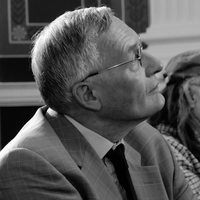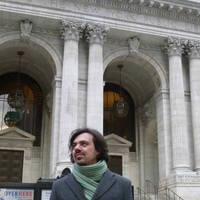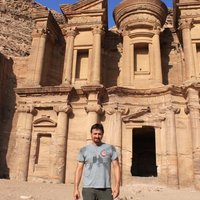Papers by Theo Maarten van Lint
Journal of Jewish Studies, Apr 1, 2010

In The Gardens of Silihdar , Zabel Essayan's lyrical description of her youth, there is among... more In The Gardens of Silihdar , Zabel Essayan's lyrical description of her youth, there is among the male family members an uncle whose warmth and liveliness always attracted the little girl. The poetic and musical strand of the travelling bard ran in the family; her great-grandfather Sirin and his brother Farhad, who led caravans to Baghdad, Persia and India, were asul and meddah or storyteller. This chapter briefs by no means exhaustive survey of philological work carried out on the Armenian poetic legacy up to the eighteenth century will be given, preceded by a consideration of the place of oral transmission as compared with the written, and the consequences of this for the method of editing of Armenian poetry. The composition of a repertorium of Armenian poems in the form of an easily accessible database will be proposed as one of the means to advance the field. Keywords: Sirin; asul; Armenian poetic legacy; Farhad; meddah; repertorium ; The Gardens of Silihdar
The Encyclopedia of Christian Civilization, Nov 25, 2011
Christian presence in Armenia predates the establishment of Christianity as the official state re... more Christian presence in Armenia predates the establishment of Christianity as the official state religion. The Armenian Apostolic Church claims autocephaly, based on the alleged ministries in Armenia of the apostles Thaddaeus and Bartholomew. Thaddaeus is connected with the early Armenian version of the Syriac Doctrine of Addai, while Bartholomew's cult in Armenia dates from the 7th century. The story of the conversion by Thaddaeus of the late 1st century King Sanatruk, and that of the martyrdom of his daughter Sandukht, probably date from the 4th century. Keywords: Armenian apostolic church; Arcasid kings, who favored Arianism; translation of the bible, and the Septuagint; oldest hymns (sharakans); Roman and sassanian empires; Armenian church's attitude toward Islam; Armenians and Caliphate, deteriorating relations

Renaissance Quarterly, 2020
This exhibition catalogue offers 352 large format pages (11 x 9.5 inch, 28 x 24 cm) of exquisite ... more This exhibition catalogue offers 352 large format pages (11 x 9.5 inch, 28 x 24 cm) of exquisite images, mostly by the renowned Hrayr Hawk Khatcherian, and text of a high scholarly level, accessible to all interested in Armenia's art, religion, and trade in the Middle Ages and the early modern period. The juxtaposition of these three themes is judicious and provides ample opportunity to approach the subject in an insightful and innovative manner. The exhibition at the Metropolitan Museum of Art in New York was curated by Dr. Helen C. Evans, the museum's curator for Byzantine art. The nineteen contributors range from museum research assistants and rising scholars to curators, leading academics, and museum directors. The catalogue proceeds in chronological order. Five survey chapters each precede briefer notes on particular subjects and descriptions of the 143 exhibits. The chapter opening the first section, "Armenians and their Middle Age" (28-79), concisely surveys the entire period and the themes covered, while the subsections and exhibits roughly cover the period to the fall of the Armenian kingdoms in the eleventh century. Further chapters introducing four chronologically arranged sections follow: "Greater Armenia and the Medieval World" (80-127), "Armenians Expand West: The Kingdom of Cilicia" (128-70), "Armenian Global Connections in the Early Modern World" (171-261), and "Armenians in New Julfa" (262-303). Partially constrained by the lack of preserved objects, but predominantly driven by the concept of Armenia underpinning the exhibition, the exhibits consist of illuminated manuscripts, four-sided stele and khachkars (cross-stones), architectural ornaments in stone and wood, reliquaries, jewelry, ceramics and glass, liturgical objects and vestments, early printed books, and three maps. A glossary (304), extensive notes often providing highly useful additional information (305-23), a sizable bibliography (324-44), and an index (345-50) complete the volume. Maps bookend the volume. The front inside cover depicts the oldest printed Armenian language map, produced in 1695 by the Vanandetsi printing house in Amsterdam, using copper plates engraved by the Dutch Schoonebeek brothers (cat. 143). The back inside cover shows part of a map of the Armenian churches and monasteries in the Ottoman Empire, made in 1691 by the Constantinople Armenian Eremia Ch'elepi K'eomiwrchean for Marsili, a member of the Venetian embassy to the Ottoman Empire (cat. 142). The map "highlight[s] the Armenian networks of control through trade, culture and religion" (301). The quotation also covers the entire volume, inviting us to rethink concepts of state, nation, and identity. The volume suggests, and herein lies an important aspect of its purpose, that the resilience of Armenian culture does not primarily reside within state borders, but in the fluidity of its transnational connectedness. Armenian culture is presented through many exquisite pieces of visual art to show that it is entangled, carried by language, faith, and script, capable of building REVIEWS 1343

Set like a stronghold south-west of the Caucasus mountains, Armenia is caught between East and We... more Set like a stronghold south-west of the Caucasus mountains, Armenia is caught between East and West. Briefly, a great empire in the first century BCE under King Tigranes the Great, Armenia was later incorporated first by the Sasanian and then the Byzantine Empires. Armenian art, literature, religion and material culture have reinterpreted elements of a wide variety of cultures. Spanning over two and a half millennia, the history of Armenia and the Armenian people is a series of riveting tales, from its first mention under the Achaemenid King Darius I to the independence of the Republic of Armenia from the Soviet Union. With the help of the Bodleian Libraries’ magnificent collection of Armenian manuscripts and early printed books, this volume tells the story of the region through the medium of its cultural output. Together with introductions written by experts in their fields, close to one hundred manuscripts, works of art and religious artefacts serve as a guide to Armenian culture and history. Gospel manuscripts splendidly illuminated by Armenian masters feature next to philosophical tractates and merchants’ handbooks, affording us an insight into what makes the Armenian people truly unique, especially in the shadow of the genocide that threatened their annihilation a hundred years ago: namely their spirituality, language and perseverance in the face of adversity.
Comparative Literature Studies, 2010

Oxford University Press eBooks, Jan 18, 2018
This chapter details how Armenian historiography was closely tied to the spread and defense of Ch... more This chapter details how Armenian historiography was closely tied to the spread and defense of Christianity in Armenia, which had been declared the state religion by King Trdat at around 314. Because Armenia had been within the Iranian cultural and religious orbit from Achaemenid times onwards, the emergence of a Western orientation promoted by the Armenian Church meant a categorical change in outlook, which would dominate its historiography. Often contested between powerful eastern and western neighbours, various royal dynasties reigned over Armenia, the last one — the Arsacid — being of Parthian origin and acceded to power in the first century AD. However, major religious conflicts, particularly between Mazdeism and Christianism, left a deep imprint on Armenian historiography, and have long prevented it from acknowledging the Iranian elements in the wider Armenian social and cultural spheres.
De Gruyter eBooks, Aug 22, 2016
Church History and Religious Culture, 2009
Scope Church History and Religious Culture (CHRC, formerly: Nederlands Archief voor Kerkgeschiede... more Scope Church History and Religious Culture (CHRC, formerly: Nederlands Archief voor Kerkgeschiedenis/Dutch Review of Church History) is a long-established, peer-reviewed periodical, primarily devoted to the history of Christianity. The journal publishes research on all periods of the history of Christianity, and on any aspect of it. This includes, but is not limited to, articles that relate the history of Christianity and Christian theology to the history of philosophy, the history of science, the history of economics, or the history of law. Frequent theme issues allow deeper, cutting-edge discussion of selected topics. An extensive book review section is included in every issue keeping you up to date with all the latest information in the field of church history.

BRILL eBooks, 2015
This chapter concentrates on merchant patronage of sacred spaces in the central node of the tradi... more This chapter concentrates on merchant patronage of sacred spaces in the central node of the trading network. It summarizes the dynamics of the relationship between the Armenian merchants and the Safavid Crown in relation to New Julfa's Christian sacred spaces. The chapter describes the style of religious building and decoration in New Julfa. It focuses on the churches of Mec Meydan, the quarter ( tasnak , lit. tenth part) that formed the commercial heart of New Julfa, namely Surb Astuacacin, Surb Betʿlehem, and the Cathedral, Surb Amenapʿrkicʿ. Visual similarities between buildings in New Julfa and Isfahan represent the continuous human contacts and interrelations between Apostolic Armenians, Catholic Armenians, Catholic missionaries, and Muslims. For this reason, the chapter emphasizes patronage to underscore that New Julfa's sacred spaces are the result of the hopes and ambitions of particular individuals. Keywords: Armenian merchants; Catholic missionaries; Isfahan; Mec Meydan church; Muslims; New Julfa's Christian sacred spaces; Safavid Crown; Surb Amenapʿrkicʿ; Surb Astuacacin; Surb Betʿlehem
St Nersess Theological Review
Analyse d'inscriptions armeniennes provenant du Sinai et mises au jour a Vale of Ejilah, en I... more Analyse d'inscriptions armeniennes provenant du Sinai et mises au jour a Vale of Ejilah, en Israel. Gravees sur des rochers de granite, elles datent du Ier millenaire ap. J.-C. Etude paleographique, proposition d'interpretation de ces inscriptions.
Revue des Études Arméniennes, 1997
In the course of a visit to Noravank{ in the autumn of 1994 two inscriptions were noted which are... more In the course of a visit to Noravank{ in the autumn of 1994 two inscriptions were noted which are not included in the CIA. One was observed on the ground to the south of the larger church complex of St Karapet 1. The stone is clearly a tombstone, and it is set in the ground, perhaps covering a tomb. TOMBSTONE 1 ZGE"EWKAyF˘Oy˘ ∏A" 1 The beautifully blossoming flow-2 IKN ç Z≥AZOI"È‚MAN 2 er and proudly branched chi-3 OIKN ZAMIR HASAN yIfi 3 ld Amir Hasan, reme-4 EwÈ≥ YA" : ˘V : cø 4 ber in (your) prayers.
Revue des Études Arméniennes, 1997
JERUSALEM * The preliminary edition of the inscriptions published here was prepared in M.E. Stone... more JERUSALEM * The preliminary edition of the inscriptions published here was prepared in M.E. Stone's seminar on Armenian paleography and epigraphy at the Hebrew University of Jerusalem 1995-1996. M.E. Stone is responsible for the text of the article, and Th. M. van Lint and J. Nazarjan made substantial contributions to the decipherment of the inscriptions and the first draft of the notes on them. 1 See THOMSON 1967; LELOIR 1986-87. 2 M.E. STONE will publish a detailed study of this source in the close future. 3 STONE 1990-91; and 1990.

The Oxford Handbook of Byzantine Literature, 2021
Evidence for the use of Greek by Armenians dates from the Hellenistic period, when Greek and Aram... more Evidence for the use of Greek by Armenians dates from the Hellenistic period, when Greek and Aramaic were court languages. The first written translations from Greek into Armenian were made much later, from the fifth century ce onward, when an alphabet for the Armenian language was devised (c. 405), following the adoption of Christianity in probably c. 314. The Bible and patristic texts were translated from Syriac and Greek, followed by liturgical and philosophical texts, as well as ecclesiastical documents, such as council canons and correspondence with church dignitaries. Education in the Eastern Mediterranean schools provided a matrix for the inculturation of religious and secular texts written in Greek. Some of the texts preserved in Armenian reflect either a more ancient redaction than the oldest preserved Greek manuscripts, or represent witnesses to texts no longer extant in Greek. Attention is given in this sub-chapter to translation techniques and their potential correlation ...











Uploads
Papers by Theo Maarten van Lint
With the help of the Bodleian Libraries’ magnificent collection of Armenian manuscripts and early printed books, this volume tells the story of the region through the medium of its cultural output. Together with introductions written by experts in their fields, close to one hundred manuscripts, works of art and religious artefacts serve as a guide to Armenian culture and history. Gospel manuscripts splendidly illuminated by Armenian masters feature next to philosophical tractates and merchants’ handbooks, affording us an insight into what makes the Armenian people truly unique, especially in the shadow of the genocide that threatened their annihilation a hundred years ago: namely their spirituality, language and perseverance in the face of adversity.